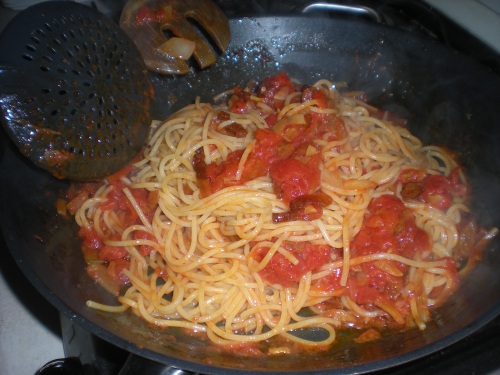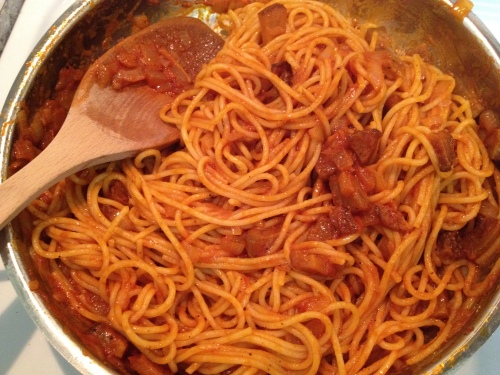A Farmer’s Pasta in Six Ingredients
by Chris
“Guanciale” comes from guancia, the Italian word for cheek. Guancia also means pillow, for where do you rest your cheek at night? Guanciale, a strip of meat, comes from a pig’s cheek that has been cured. The cut is some 90% fat. I seldom eat meat, but in the hour before I do, something like guanciale arrives on my cutting board.
My favorite pasta calls for guanciale, spaghetti, onions, olive oil, tomato purée, and Parmesan cheese. Should you be unable to find guanciale, pancetta can substitute. But Guanciale gives the pasta a deeply animal flavor that takes you to a place out of time, to a sad barn in the hills, to the campfire of Stone Age hunters, to a savage and dirty place where tofu and cream-white chicken have never been tasted.
I learned to cook this pasta in Italy, from the owner of a farm near Bologna, where I worked a few summers ago. “A farmer’s pasta,” he often said while preparing the dish. (It appears on menus as spaghetti amatriciana.) Here’s his version:
And mine:
And a recipe:
Spaghetti Amatriciana (“a farmer’s pasta”)
Serves 2
1 tbsp olive oil
1/4 lb guanciale, cut into 1/2-inch cubes
1 small onion, chopped
1 cup tomato purée (or crushed tomatoes, etc.)
1/2 lb spaghetti
Parmesan cheese to taste
1) Put two paper towels on a plate beside your stove. Sauté guanciale in olive oil over medium heat, stirring often. After three or four minutes, when the guanciale is browned and a pool of grease coats the pan, transfer guanciale with a slotted spoon to the paper towels. Use paper towels to lazily wrap the guanciale.
2) Sauté onion in the guanciale’s grease for three minutes over medium-low heat. Pour in tomato purée. Let simmer, stirring occasionally.
3) Cook the spaghetti in salted water (about 1 tsp. salt) until al dente. Drain spaghetti. Add to simmering sauce. Add guanciale. Kill heat. Stir well. Sprinkle Parmesan onto the pasta. Eat.



I am so making this tomorrow night!
Now there is a cut of meat I did not know about. I really appreciate the use of the entire animal, even if it’s hard to wrap my head around eating cheeks, elbows, or necks.
Wonderful post! love you blog Echoes and Mementos
I love this recipe – so rustic, so delicious. And extra thanks for the background on guanciale.
Dude, I had guanciale in Ecuador mixed with riced. Well…it was more like fat from the back of the neck area I think. Similar ratio. It was smoked over my host family’s open pit “stove” for months. Your description of a “sad bar somewhere” is the most on point thing I’ve heard in a while.
— Much Love,
Benjamin Hartung
Hey, Ben. That sounds amazing. There’s a Latin American place in Hoboken that we should try if you make it up here.
Lovely photos again!
Paola
Did you get the guanciale at the Chelsea Market again or was this when you made it over Halloween weekend.
No Garlic?
Same pasta as Halloween weekend, but a new butcher supplied the guanciale. It had less personality than the other cut. Yeah, no garlic in this one.
It looks good! Why not just use bacon? I live in Honduras and Guanciale would be next to impossible to acquire here. I’ll try it with bacon though.
Yum!!
What a unique blog you have here… simple, pure. I like it…
Hi Chris, thanks for stopping by my blog 🙂 I like your recipes, especially this one since it’s nice & simple. Interesting btw that you learned this recipe from someone from Bologna and use parmigiano reggiano, whereas the original (for what it’s worth, recipes are different in every village or every family in Italy!) comes from Rome and uses pecorino romano.
Hi Stefan,
Yes, I ate a lot of parmigiano-reggiano in Bologna. The city is a short ride from Parma, the town that gives its name to the cheese. I’m pretty sure most of the cities in Emilia-Romagna prefer parmigiano-reggiano because, taste aside, the cheese comes from the region.
-Chris
I”d like to know more about your experience at the farm near Bologna.
My Father in 1944 ended up in an Olive Tree near Bologna after his B17 was shot down. A family hid him from the Germans temporarily . Thats really all i know. Im a Chef in Ohio and I’m doing a private dinner paying homage to the food of that area specifically.
And to my 96 yr. old Dad who just passed 3/21/12.
I’m sourcing authentic recipes and as best and close as possible to that area,…Ingredients. Any suggestions/direction would be appreciated
Jonathan Kouse
I also have a blog recently started on word press
chefswtf
(chefs watching the food)
Hi J,
I heard a few war stories while in Bologna. We tend to forget the World War II, or at least don’t remember it directly, because the fighting happened in strange lands across an ocean. Those lands recall the war clearer than we do, and when we go to them we can, when listening in the right places, hear echoes of the conflict even today.
Real quick: An old man who stalked a vineyard in which I worked had spent some five years in a concentration camp. We had no language in common. I heard his story from my “boss.” The old man would wave at me with a fistful of pruned grape leaves while I walked out to the trellises to cut grass. That was it. Also: a tank of Italians drunk and winding through the Alps, the war over, they returning home, more drinking, and the tank teetering off a cliff. The old man saw this on his walk back to Italy. J, I will be posting on your site soon.
-Chris